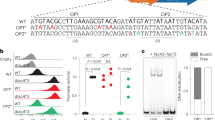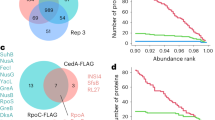Abstract
The tetracycline repressor (TetR) regulates the most abundant resistance mechanism against the antibiotic tetracycline in gram-negative bacteria. The TetR protein and its mutants are commonly used as control elements to regulate gene expression in higher eukaryotes. We present the crystal structure of the TetR homodimer in complex with its palindromic DNA operator at 2.5 Å resolution. Comparison to the structure of TetR in complex with the inducer tetracycline-Mg2+ allows the mechanism of induction to be deduced. Inducer binding in the repressor core initiates conformational changes starting with C-terminal unwinding and shifting of the short helix α6 in each monomer. This forces a pendulum-like motion of helix α4, which increases the separation of the attached DNA binding domains by 3 Å, abolishing the affinity of TetR for its operator DNA.
This is a preview of subscription content, access via your institution
Access options
Subscribe to this journal
Receive 12 print issues and online access
$189.00 per year
only $15.75 per issue
Buy this article
- Purchase on Springer Link
- Instant access to full article PDF
Prices may be subject to local taxes which are calculated during checkout




Similar content being viewed by others
Accession codes
References
McMurry, L., Petrucci, R.E. & Levy, S.B. Proc. Natl. Acad. Sci. USA 77, 3974–3977 (1980).
Yamaguchi, A., Iwasaki-Ohba, Y., Ono, N., Kaneko-Ohdera, M. & Sawai, T. FEBS Lett. 282, 415–418 (1991).
Schnappinger, D. & Hillen, W. Arch. Microbiol. 165, 359–369 ( 1996).
Hillen, W. & Berens, C. Ann. Rev. Microbiol. 48, 345–369 (1994).
Bertrand, K.P., Postle, K., Wray, Jr., L.V. & Reznikoff, W.S. Gene 23, 149–156 ( 1983).
Eckert, B. & Beck, C.F. J. Bacteriol. 171, 3557–3559 (1989).
Kleinschmidt, C., Tovar, K., Hillen, W. & Pörschke, D. Biochemistry 27, 1094–1104 ( 1988).
Lederer, T., Takahashi, M. & Hillen, W. Anal. Biochemistry 232, 190– 196 (1995).
Gossen, M., et al. Science 268, 1766– 1769 (1995).
Freundlieb, S., Baron, U., Bonin, A.L., Gossen, M. & Bujard, H. Methods Enzymol. 283, 159– 173 (1997).
Rossi, F.M.V. & Blau, H.M. Curr. Opin. Biotechnol. 9, 451– 456 (1998).
Förster, K., et al. Nucleic Acids Res. 27, 708– 710 (1999).
Baron, U., et al. Proc. Natl. Acad. Sci. USA 96, 1013 –1018 (1999).
Hinrichs, W. et al. Science 264, 418–420 (1994).
Kisker, C., Hinrichs, W., Tovar, K., Hillen, W. & Saenger, W. J. Mol. Biol. 247, 260– 280 (1995).
Orth, P. et al. J. Mol. Biol. 279, 439– 447 (1998).
Otwinowski, Z., et al. Nature 335, 321–329 (1988).
Lewis, M. et al. Science 271, 1247–1254 (1996).
Schumacher, M.A., Choi, K.Y., Lu, F., Zalkin, H. & Brennan, R.G. Cell 83, 147– 155 (1995).
Steitz, T.A., Ohlendorf, D.H., McKay, D.B., Anderson, W. & Matthews, B.W. Proc. Natl. Acad. Sci. USA 79, 3097–3100 (1982).
Heuer, C. & Hillen, W. J. Mol. Biol. 202, 407–415 (1988).
Sizemore, C., Wissmann, A., Gülland, U. & Hillen, W. Nucl. Acids Research 18, 2875–2880 (1990).
Wissmann, A. et al. EMBO J. 10, 4145–4152 (1991).
Baumeister, R., Helbl, V. & Hillen, W. J. Mol. Biol. 226, 1257– 1270 (1992).
Helbl, V., Berens, C. & Hillen, W. J. Mol. Biol. 245, 538– 548 (1995).
Schwabe, J.W.R. Curr. Opin. Struct. Biol. 7, 126–134 (1997).
Harrison, S.C. Nature 353, 715–719 ( 1991).
Müller, G. et al. Nature Struct. Biol. 2, 693– 703 (1995).
Orth, P., Saenger, W. & Hinrichs, W. Biochemistry 38, 191– 198 (1999).
Degenkolb, J., Takahashi, M., Ellestad, G.A. & Hillen, W. Antimicrob. Agents Chemother. 35, 1591– 1595 (1991).
Orth, P. et al. J. Mol. Biol. 285, 455– 461 (1999).
Arvidson, D.N., Lu, F., Faber, C., Zalkin, H. & Brennan, R.G. Nature Struct. Biol. 5, 436 –441 (1998).
Schumacher, M.A., Glasfeld, A., Zalkin, H. & Brennan, R.G. J. Biol. Chem. 272, 22648–22653 ( 1997).
Kercher, M.A., Lu, P. & Lewis, M. Curr. Opin. Struct. Biol. 7, 76–85 (1997).
Orth, P., Alings, C., Schnappinger, D., Saenger, W. & Hinrichs, W. Acta Crystallogr. D 54, 99–100 (1998).
Otwinowski, Z. & Minor, W. Methods Enzymol. 276, 307–326 ( 1997).
Collaborative Computational Project, Number 4. Acta Crystallogr. D 50, 760–776 (1994).
Navaza, J. Acta Crystallogr. A 50, 157–163 (1994).
Jones, A.T., Zou, J.-Y., Cowan, S.W. & Kjeldgaard, M. Acta Crystallogr. A 47, 110–119 ( 1991).
Brünger, A.T. X-PLOR Manual version 3.843 (Yale University Press, New Haven, Connecticut; 1996).
Ravishanker, G., Swaminathan, S., Beveridge, D.L., Lavery, R. & Sklenar, H. J. Biomol. Struct. Dyn. 6, 669–699 (1989).
Kraulis, P.J. J. Appl. Crystallogr. 24, 946–950 (1991).
Merritt, E.A. & Murphy, M.E.P. Acta Crystallogr. D 50, 869–873 (1994).
Acknowledgements
Helpful discussions with A. Steinmetz and T. Simonson (IGBMC, Strasbourg) and DNA purification and cocrystallization by C. Alings are gratefully acknowledged. This work was supported by grants of the Deutsche Forschungsgemeinschaft (Sonderforschungsbereich 344) and by Fonds der Chemischen Industrie.
Author information
Authors and Affiliations
Corresponding authors
Rights and permissions
About this article
Cite this article
Orth, P., Schnappinger, D., Hillen, W. et al. Structural basis of gene regulation by the tetracycline inducible Tet repressor–operator system. Nat Struct Mol Biol 7, 215–219 (2000). https://doi.org/10.1038/73324
Received:
Accepted:
Issue Date:
DOI: https://doi.org/10.1038/73324
This article is cited by
-
Structures of the DarR transcription regulator reveal unique modes of second messenger and DNA binding
Nature Communications (2023)
-
Systematic analyses identify modes of action of ten clinically relevant biocides and antibiotic antagonism in Acinetobacter baumannii
Nature Microbiology (2023)
-
The TetR-type regulator AtsR is involved in multidrug response in Corynebacterium glutamicum
Microbial Cell Factories (2022)
-
Mycobacterium tuberculosis Rv3160c is a TetR-like transcriptional repressor that regulates expression of the putative oxygenase Rv3161c
Scientific Reports (2021)
-
Molecular basis for control of antibiotic production by a bacterial hormone
Nature (2021)



